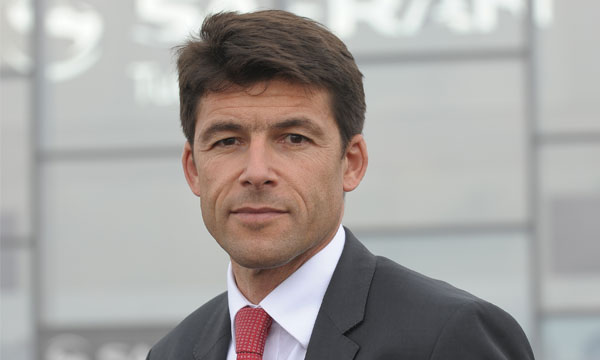For Bruno Even, CEO of Safran Helicopter Engines, |
| Interview by Léo Barnier |
|
|
29 SEP 2017 | 1184 words
|
 |
Picture © Rémy Bertrand – Safran |
|
|
|
Appointed CEO of Safran Helicopter Engines in 2015, Bruno Even had previously been Chief Executive of Sagem. A graduate of Polytechnique and SupAéro, he began his career at the French DGA (Directorate General of Armaments). Here he explains to Le Journal de l'Aviation the current challenges facing Safran Helicopter Engines, on both the civilian and military markets.
How is the civilian helicopter engine market doing?
We need to face facts: the civilian helicopter market has been suffering a serious drop over the last two to three years, with orders down nearly 30% worldwide. The situation surrounding the price of a barrel of oil pulling the offshore market downwards, the over-capacity in certain markets such as EMS in the United States and the economic situation in South America are all factors which lead us to think that we have hit the bottom of the market. I can't see any recovery for the next year or two. The market will remain stable, with no major recovery. However, we need to be realistic and cautious; the market isn't going to blow up from one day to the next.
In the long term, there will be perspectives for growth on the European and American markets, as this is a market in renewal, with new platforms needed for new market requirements, whether for mission performance consumption or noise. There's no doubt that the market will exist.
The real driving force behind medium and long term growth is the developing countries. Certain parameters are tending to confirm that the market will start up gradually and give everything a boost over the long term. Among the developing countries we can mention China first of all, which recorded a higher order level for light, single-engine helicopters than the United States.
Speaking of which, what is Safran Helicopter Engines's strategy in relation to China and developing countries in general?
Safran Helicopter Engines has a historically strong position in development countries. We need to be able to seize the opportunities for growth when the market picks up again. With first first flights last year and five new engines, helicopters will be coming into service over the next few years and so will represent extra market share for us.
In China, we have a very strong partnership with AVIC and local industrial companies and we have been investing for years, whether on licence contracts for Arriel engines or the development of the WZ16/Ardiden 3C, which will equip the AC352s (the Chinese version of the H175, ed.). We have already invested and of course we will continue to invest along these lines to enable us to seize the development and sales opportunities for Airbus Helicopters or Bell.
What about the military market?
Thanks to certain major campaigns and in particular thanks to the partnership with Airbus Helicopters on the H225M, the military market looks like it's holding its own. In the current context, this is a strong signal which gives visibility. There is also a sales and support aspect, through operations, which maintains a certain level of activity for military customers, which is a good thing.
However, we must not ignore the repercussions of the falling oil prices, which despite everything leads to savings, especially in countries which depend on oil and which are seeing their budgets reducing, in areas such as the Middle East, South America and South East Asia. Even if there have been successes, the current climate is applying pressure to budgets and is leading to decisions being delayed on other campaigns.
In terms of military MRO, the trend seems to be moving towards service contracts...
Developing support and providing customer satisfaction is clearly at the heart of our strategy. In relation to the stakes involved, we have put service contracts in place to improve the availability of engines in service and we make commitments to these contracts. Nearly 50% of service contracts are flight hour contracts. The first contracts of this type were put in place for the civilian market, which was the first to express the need for long term flight hour contracts to provide visibility.
Military customers are demanding them more and more. We started with the French Government in 2001 with the MCO contract, which was renewed in 2012 for a further ten years based on the first contract. The service contract is a real market trend. We have also developed this offer for other customers, such as the British, Brazilian, Malaysian and Singaporean armies and also with the American army under the Lakota contract. This type of contract is gradually becoming a standard, which we are imposing little by little.
The service contract is very important in terms of visibility. It is a dynamic which has been successful and which gives a commercial boost, link the GSP contracts (Global support package, ed.) signed in 2016 for the support of Danish RTM 322s and the NAHEMA (NATO helicopter management agency) for Belgian, French and Dutch NH90s.
What are Safran Helicopter Engines's priorities for the years to come?
In our medium/long term vision, we have put a strategy in place based on four pillars to be able to seize growth in the renewal market and in developing countries.
First of all, we need to be able to diversify our integrator customer base and consolidate our market share, to enable us to be more robust and able to provide solutions to all helicopter manufacturer customers. While we have a historic link with Airbus Helicopters, which we have built up over several years, at the same time we need to be able to become the key engine provided for other helicopter producers.
As for developing countries, we need to strengthen our presence with new industrial partnerships, like the joint enterprise founded in 2016 with HAL in India, to maintain and support the full engine fleet.
Innovation is also clearly at the heart of our strategy. We need to continue to innovate, even during this difficult market period. We are maintaining our investment, with over 15% of revenue dedicated to RTDI (Research, development, technology and innovation), to enable us to propose the most competitive engines and services. We will be innovating through the renewal of our engine range: the Arrano which took its first flights on the H160, is in its intensive test phase and should be certified by the end of 2018 with an unrivalled performance level; the Ardiden 3G has received its EASA certification and will provide a 10 to 15% reduction in fuel consumption, which is huge in the current climate; we are on board the Racer demonstrator with the RTM 322 and are planning to test a "stop and start" concept by 2020, to name just a few initiatives. To conclude, we are planning to develop a new family of high power engines for the 2500/300 HP market.
The fourth pillar is customer satisfaction. This is the start of the loop, as a satisfied customer is a customer who will want to keep working with us; this is why we are continuing to invest in this area.
|
|
 |
Léo Barnier
Specialized journalist
Industry & Technology, Equipments, MRO
|
|
| |
They made this section possible |
|
|
|
|
|
|
|
|
|
|
|
|
|
|
|
|
Top stories |
|
|
|
|
|
Top stories
|